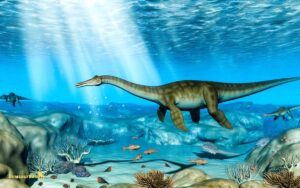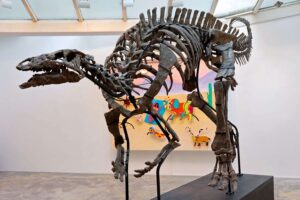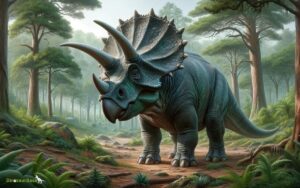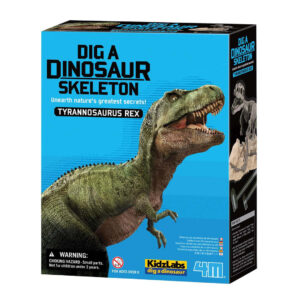Are We Dinosaurs? Exploring Humanity’s Place in History
We are not dinosaurs; our species emerged long after their extinction. Dinosaurs roamed the Earth until approximately 65 million years ago.
Humans often ponder their place in the history of Earth. While dinosaurs were the ruling vertebrates for over 160 million years, Homo sapiens, modern humans, have only been around for roughly 300,000 years. This vast gap in time highlights the fleeting presence of humanity compared to the age-long reign of the dinosaurs.
Our fascination with these ancient creatures stems from their impressive size, diversity, and the mystery surrounding their sudden demise. Exploring the differences between our species and dinosaurs offers insights into evolution, adaptability, and the ever-changing dynamics of life on Earth. Understanding this monumental gap in existence helps clarify that, despite our significant advances, we are merely a blip in Earth’s extensive natural history.
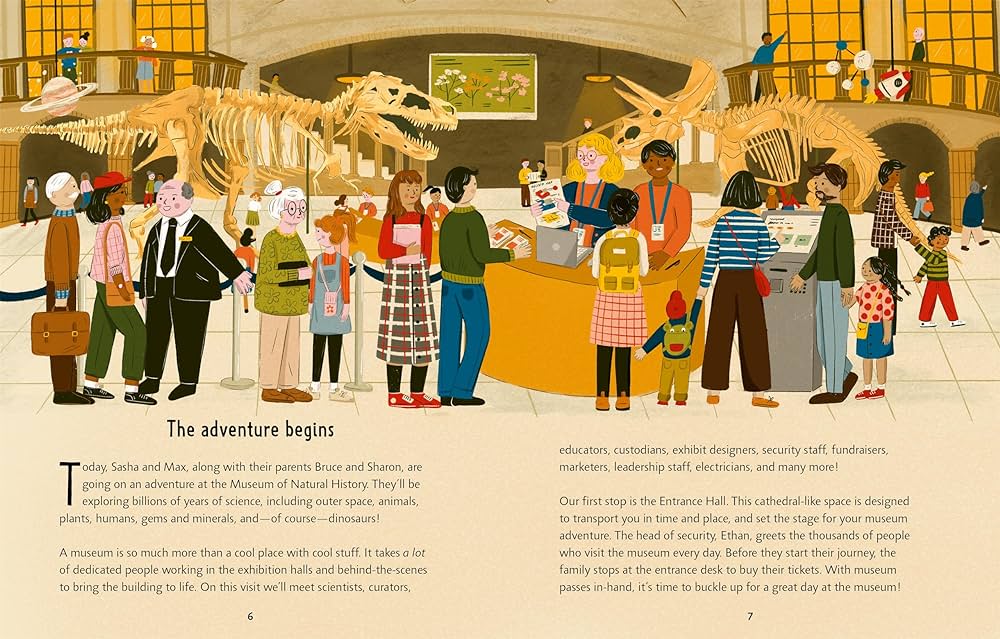
A Glimpse At Earth’s Time Scale
Time is like a long, winding river, and Earth’s history stretches far beyond our brief human moments. To truly appreciate our place on this ancient Earth, let’s dive into the vastness of geological time—a saga where our planet transforms and life evolves.
The Age Of The Earth
Our planet, Earth, is a 4.54-billion-year-old masterpiece. This age comes from rocks and minerals, the oldest storytellers. Scientists study these to understand Earth’s timeline. Let’s break this down with a simple table:
| Eons | Major Events |
|---|---|
| Hadean | Earth forms |
| Archean | First life appears |
| Proterozoic | Oxygen rises |
| Phanerozoic | Dinosaurs dominate |
Each eon holds countless stories of change and growth. Phanerozoic, the latest, has a special chapter called the Mesozoic—the age of reptilian rulers.
Extinct Giants: The Reign Of Dinosaurs
Dinosaurs claimed Earth for 165 million years. This era splits into three periods: Triassic, Jurassic, and Cretaceous. Here’s a peek at each period:
- Triassic: First dinosaurs show up.
- Jurassic: Massive giants roam freely.
- Cretaceous: Birds emerge as dinosaurs fade away.
These creatures became fossils—clues locked in stone. Fossils help us picture these ancient beasts. The mighty T-Rex and elegant Brachiosaurus were once real, walking on the same earth we do now.
So, are we dinosaurs? Not quite, but like them, we share the gift of calling this age-old Earth our home.

Credit: hindmanauctions.com
Humanity’s Fleeting Moment
Imagine a world where humans are just a blip in time. That’s our Humanity’s Fleeting Moment. Dinosaurs ruled for millions of years. Still, our presence on Earth barely scratches the surface of the planet’s history. Think of history as a 24-hour clock. Dinosaurs appeared at 11:00 pm and vanished around 11:40 pm. Humans? We showed up at 11:59:58 pm!
The Dawn Of Humankind
The story of humans begins only a few million years ago. Our ancestors took their first walk in Africa. This might seem ancient, but it’s nothing next to dinosaurs. They had 165 million years to roam. Our human lineage splits from chimpanzees around seven million years ago. It’s a blink in Earth’s grand timeline!
- First ancestors: Australopithecus
- Using tools: 2.6 million years ago
- First fire: 1 million years ago
- Modern humans: 300,000 years ago
Civilization’s Brief Timeline
Next, let’s look at civilizations. These complex societies with cities and governments are even more recent. Farming started around 12,000 years ago. Cities and writing emerged 5,000 years past. When we map out human history, these moments happen in the very last minute of the Earth’s day.
| Agriculture | Cities | Writing |
|---|---|---|
| 12,000 years ago | 5,000 years ago | 5,000 years ago |
Mass Extinctions: Patterns And Consequences
Life on Earth has faced mighty challenges over its vast history. Mass extinctions stand out as natural world’s pivotal moments. These events shape our planet’s biological diversity. They destroy and create, leading to the rise and fall of species. To understand these patterns and consequences, let’s dive into the importance of studying past extinctions.
Nature’s Reset Buttons
Mass extinctions act like Nature’s Reset Buttons. They change life on Earth. These large-scale events have happened five times already. They hit the reset button on our planet’s ecosystems. As a result, new forms of life emerge.
- The Ordovician-Silurian, when 86% of species vanished.
- The Late Devonian, with a 75% loss.
- The Permian, known as ‘The Great Dying’, erased 96%.
- The Triassic-Jurassic, saw 80% species disappear.
- The Cretaceous-Paleogene, ended the reign of dinosaurs.
Lessons From The Past
Lessons from past extinctions are vital. They show us survival and recovery patterns.
| Extinction Event | Survival Strategy | Recovery Period |
|---|---|---|
| The Permian | Adaptability | Millions of years |
| The Cretaceous-Paleogene | Small size, varied diet | Fast for mammals |
These events teach us how species adapt and survive. They provide insight into how ecosystems rebuild. For example, mammals thrived after the dinosaurs vanished. Studying these patterns helps us prepare for future changes.
Modern Behemoths: Comparing Humans And Dinosaurs
Imagine towering giants walking the Earth. Long ago, dinosaurs ruled, their immense size and power unmatched. Today, with skyscrapers and vast technology, humans dominate. Let’s explore this fascinating comparison and understand what makes us both alike and unalike these ancient creatures.
Dominance Over Earth
Dinosaurs once dominated the planet. They were like nature’s engineers, changing landscapes and ecosystems. Humans mirror this impact, but with technology. We build cities, reshape the land, and influence all life on Earth. Here’s a quick look at this domination:
- Dinosaurs: Ruled for over 160 million years
- Humans: Have built civilizations over mere thousands
Survival Against Odds
Both species faced great challenges. Massive extinctions tested dinosaurs, but they adapted and thrived. Humans too face challenges, from climate change to global pandemics. Our ability to adapt defines our future, just as it once did for the dinosaurs.
| Dinosaur Era | Human Era |
|---|---|
| Asteroids and natural disasters | Environmental and health crises |
| Adaptations like size and strength | Innovations in medicine and technology |
The Anthropocene: Are Humans The Next Dinosaurs?
The Anthropocene: Are Humans the Next Dinosaurs? paints a sobering picture. This era, shaped by humans, raises a critical question. Could our species follow the colossal footsteps of the dinosaurs? Facing environmental challenges, our actions will seal our fate, much like the ancient reptiles.
Our Environmental Footprint
The mark we leave on Earth is profound. The resources we consume can’t last forever. Pollution fills the air, land, and sea. The natural world changes at our hands. This impact is known as our environmental footprint, a trail as significant as that of the dinosaurs.
The Specter Of Human-induced Extinction
Human actions can lead to species disappearing. Just like an asteroid was a disaster for dinosaurs, human activity might become our own downfall. Our choices today can prevent or cause large-scale extinctions, including our own. The steps we take now are crucial.
Cultural Fascination With Dinosaurs
Dinosaurs ignite our imaginations and captivate our hearts like no other creatures. Their vast history and mysterious extinction lead us to wonder about a world long before humans.
Paleontology In Pop Culture
Dinosaur-themed media thrives across generations. Jurassic Park, a blockbuster movie, unleashed worldwide dinosaur mania. Toy shelves overflow with dinosaur figures. Children collect them with enthusiasm. Museums showcasing ancient bones draw huge crowds. T-shirts, video games, and books with dinosaur themes never go out of style.
- Box Office Hits: Films with dinosaurs consistently top charts.
- Educational Influence: They spark interest in science among kids.
- Merchandising Power: Dinosaur products are always in demand.
Dinosaurs As A Mirror For Humanity
These prehistoric giants reflect our fears and aspirations. They show raw strength and grace we admire. We see in them the struggle for survival, linking to our own experiences. Stories often use dinosaurs to explore themes like change, resilience, and the unknown.
| Characteristics | Reflections in Humans |
|---|---|
| Might and Power | Our desire for strength |
| Extinction | Our fears of disaster |
| Adaptation | Our ability to evolve |
We find lessons in their rise and fall. Dinosaurs remind us of earth’s changes. They encourage us to think about our place in nature’s grand tale.
Beyond Existence: Legacy And The Fossil Record
Dinosaurs once walked the Earth, their mighty presence forever imprinted in the fossil record. Likewise, the way we live our lives today creates a footprint for future generations. Let’s explore the enduring marks of our existence and how deep they might go in the sands of time.
Archiving Our Epoch
Our current geological period is full of advancements and discoveries. Our cities, bridges, and monuments stand tall and proud. But what happens to them over millions of years?
- Natural Processes: Erosion, earthquakes, and climate change can break down structures.
- Human Influence: Urban development can erase historical sites.
- Technological Imprint: Items like smartphones might survive in some form as technological fossils.
What Will Remain Of Us?
Scientists often wonder about the traces we will leave behind. Our bones will become fossils for future discoverers. Here’s a look at potential relics from our time:
| Artifact | Material | Survival Time |
|---|---|---|
| Plastics | Polyethylene | Millions of years |
| Buildings | Concrete and Steel | Thousands of years |
| Tools | Metal and Stone | Tens of thousands of years |
Pieces of our lives, such as glass bottles or ceramic pottery, will tell stories to curious minds of the future. Even our digital data, etched into CDs or hard drives, may remain clues to our digital era.

Credit: www.amazon.com

Credit: www.newscientist.com
Frequently Asked Questions On Are We Dinosaurs
Do Humans Have Dinosaur Dna?
No, humans do not have dinosaur DNA. Our genetic material is distinct from that of dinosaurs, which went extinct approximately 65 million years ago.
What Does The Bible Say About Dinosaurs?
The Bible does not explicitly mention dinosaurs. The texts predate modern scientific discovery of these creatures by several millennia.
How Did We Go From Dinosaurs To Humans?
Dinosaurs went extinct about 65 million years ago due to an asteroid impact. Mammals then evolved and diversified, leading to primates and eventually humans over millions of years.
Do We Have A Living Dinosaur?
No, we do not have any living dinosaurs. All dinosaurs, as traditionally recognized, became extinct approximately 65 million years ago.
Conclusion
Our connection with dinosaurs extends beyond mere curiosity. Their legacy informs our understanding of evolution, survival, and adaptability. As we ponder our place in Earth’s history, let’s honor these magnificent creatures. Embracing their lessons helps us forge a future as enduring as their own epic saga.

